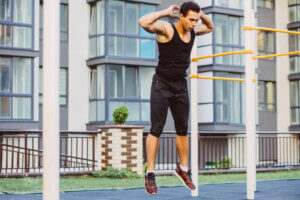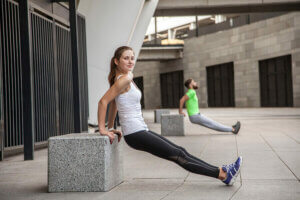Calisthenic Exercises With Your Own Body Weight

Calisthenic exercises are an excellent way to work out without having to leave the comfort of your home. The home offers a sense of security for most people, and some people prefer to avoid large groups while they exercise. For that reason, this form of exercise can be a great alternative.
To do calisthenics, the only accessories you need are the right disposition and your own body weight. With only these two pointers, there are many routines you can do to maintain your physique and keep a healthy lifestyle.
What are calisthenic exercises?
Calisthenics is a training method for all types of people. It centers around the largest muscle groups. In the beginning, calisthenics solely focused on the upper body, but over time, it adapted to all the body muscles.
The outcome of this system of exercise is to develop different physical abilities such as strength and flexibility. It also contributes to the improvement of postural hygiene, all through the proper execution of the different exercises.
Calisthenic exercises to do at home
Proper technical execution is a fundamental factor in calisthenics. However, the most important pillar of this training method is your own body weight. Solely by using your own body weight, you can do every physical routine and get great results. Here, we’ll show you some calisthenic exercises that you can do at home:
Jumping squats
These are a variety of conventional squats, but they’re especially great for the quadriceps and glutes. By adding a jump to your conventional squat, it turns it into a more complete exercise for the lower muscle groups.

On the same hand, this exercise promotes an increased heart rate, which can increase the resistance in a positive way.
Burpees: calisthenic exercises
Burpees are included in calisthenic routines since all they require is your own body weight. Their broad complexity is thanks to the combined effort of all different muscle groups of the body.

In addition, it’s necessary to be in good physical shape and have good coordination to be able to do burpees. The ideal is that you should be able to do them without any pains or injuries due to poor form.
Bench dips
Although this exercise does require a bench or wall of around 40 centimeters, the main idea of calisthenics still applies. This is because the force on the bench solely depends on the person’s body weight.

Tricep dips primarily work the agonist muscle groups, which are the brachial triceps and the deltoids. However, certain other arm and torso muscles are also involved in the execution of this exercise.
Diamond push-ups
The muscle groups of the arms get the most benefits from push-ups, which means that these muscles have to be strong in the moment of the workout. Diamond push-ups are distinguished from conventional push-ups by the form of the support. In a diamond push-up, the “diamond” shape comes from uniting the thumb and forefinger of each hand.

What to keep in mind with calisthenic exercises
A calisthenics training method is good for any type of person, regardless of gender or age. However, it’s necessary to have a certain level of physical fitness before you begin. The routines are typically divided for beginners, intermediate, and advanced athletes. The intensity of each workout determines the category.
On the other hand, the only contraindication at the time of practicing calisthenics is previous injuries. If you do enter into this training with a previous injury, you should consult with a medical professional before beginning this discipline.
Of course, it’s worth mentioning that the health and fitness of your body is the most important factor to consider when entering into any method of training. The physical recovery after an injury needs to be developed by a physical therapist and must be executed exactly as advised.
Finally, just as we’ve previously mentioned, keep in mind that calisthenics is designed to increase certain physical abilities and isn’t centered on muscular hypertrophy. However, it’s an ideal exercise to stay in top physical shape!
Calisthenic exercises are an excellent way to work out without having to leave the comfort of your home. The home offers a sense of security for most people, and some people prefer to avoid large groups while they exercise. For that reason, this form of exercise can be a great alternative.
To do calisthenics, the only accessories you need are the right disposition and your own body weight. With only these two pointers, there are many routines you can do to maintain your physique and keep a healthy lifestyle.
What are calisthenic exercises?
Calisthenics is a training method for all types of people. It centers around the largest muscle groups. In the beginning, calisthenics solely focused on the upper body, but over time, it adapted to all the body muscles.
The outcome of this system of exercise is to develop different physical abilities such as strength and flexibility. It also contributes to the improvement of postural hygiene, all through the proper execution of the different exercises.
Calisthenic exercises to do at home
Proper technical execution is a fundamental factor in calisthenics. However, the most important pillar of this training method is your own body weight. Solely by using your own body weight, you can do every physical routine and get great results. Here, we’ll show you some calisthenic exercises that you can do at home:
Jumping squats
These are a variety of conventional squats, but they’re especially great for the quadriceps and glutes. By adding a jump to your conventional squat, it turns it into a more complete exercise for the lower muscle groups.

On the same hand, this exercise promotes an increased heart rate, which can increase the resistance in a positive way.
Burpees: calisthenic exercises
Burpees are included in calisthenic routines since all they require is your own body weight. Their broad complexity is thanks to the combined effort of all different muscle groups of the body.

In addition, it’s necessary to be in good physical shape and have good coordination to be able to do burpees. The ideal is that you should be able to do them without any pains or injuries due to poor form.
Bench dips
Although this exercise does require a bench or wall of around 40 centimeters, the main idea of calisthenics still applies. This is because the force on the bench solely depends on the person’s body weight.

Tricep dips primarily work the agonist muscle groups, which are the brachial triceps and the deltoids. However, certain other arm and torso muscles are also involved in the execution of this exercise.
Diamond push-ups
The muscle groups of the arms get the most benefits from push-ups, which means that these muscles have to be strong in the moment of the workout. Diamond push-ups are distinguished from conventional push-ups by the form of the support. In a diamond push-up, the “diamond” shape comes from uniting the thumb and forefinger of each hand.

What to keep in mind with calisthenic exercises
A calisthenics training method is good for any type of person, regardless of gender or age. However, it’s necessary to have a certain level of physical fitness before you begin. The routines are typically divided for beginners, intermediate, and advanced athletes. The intensity of each workout determines the category.
On the other hand, the only contraindication at the time of practicing calisthenics is previous injuries. If you do enter into this training with a previous injury, you should consult with a medical professional before beginning this discipline.
Of course, it’s worth mentioning that the health and fitness of your body is the most important factor to consider when entering into any method of training. The physical recovery after an injury needs to be developed by a physical therapist and must be executed exactly as advised.
Finally, just as we’ve previously mentioned, keep in mind that calisthenics is designed to increase certain physical abilities and isn’t centered on muscular hypertrophy. However, it’s an ideal exercise to stay in top physical shape!
All cited sources were thoroughly reviewed by our team to ensure their quality, reliability, currency, and validity. The bibliography of this article was considered reliable and of academic or scientific accuracy.
- del Río Alijas, R., & Díaz Torre, A. (2015). Calistenia: Volviendo a los orígenes. EmásF: Revista Digital de Educación Física.
- FORSTER, N. (2014). BURPEES. Muscle & Fitness.
- Leopoldo, C. V. (2015). Las capacidades físicas. El Entrenamiento Deportivo.
This text is provided for informational purposes only and does not replace consultation with a professional. If in doubt, consult your specialist.








